Abstract
Rates and patterns of key-press responding maintained under schedules in which responding resulted in intravenous injections of cocaine were studied in squirrel monkeys and rhesus monkeys. Each injection was followed by a 60- or 100-sec timeout period. Schedule-controlled behavior was obtained at appropriate cocaine doses in each species. Under FR 10 or FR 30 schedules, performance was characterized by high rates of responding (usually more than one response per second) in each ratio. Under FI 5-min schedules, performance was characterized by an initial pause, followed by acceleration of responding to a final rate that was maintained until the end of the interval. Under multiple fixed-ratio fixed-interval schedules, rates and patterns of responding appropriate to each schedule component were maintained. Responding seldom occurred during timeout periods under any schedule studied. At doses of cocaine above or below those that maintained characteristic schedule-controlled behavior, rates of responding were relatively low and patterns of responding were irregular. Characteristic fixed-interval responding was maintained over a wider range of cocaine doses than characteristic fixed-ratio responding. Complex patterns of responding controlled by discriminative stimuli under fixed-ratio or fixed-interval schedules can be maintained by cocaine injections in squirrel monkeys and rhesus monkeys.
Full text
PDF

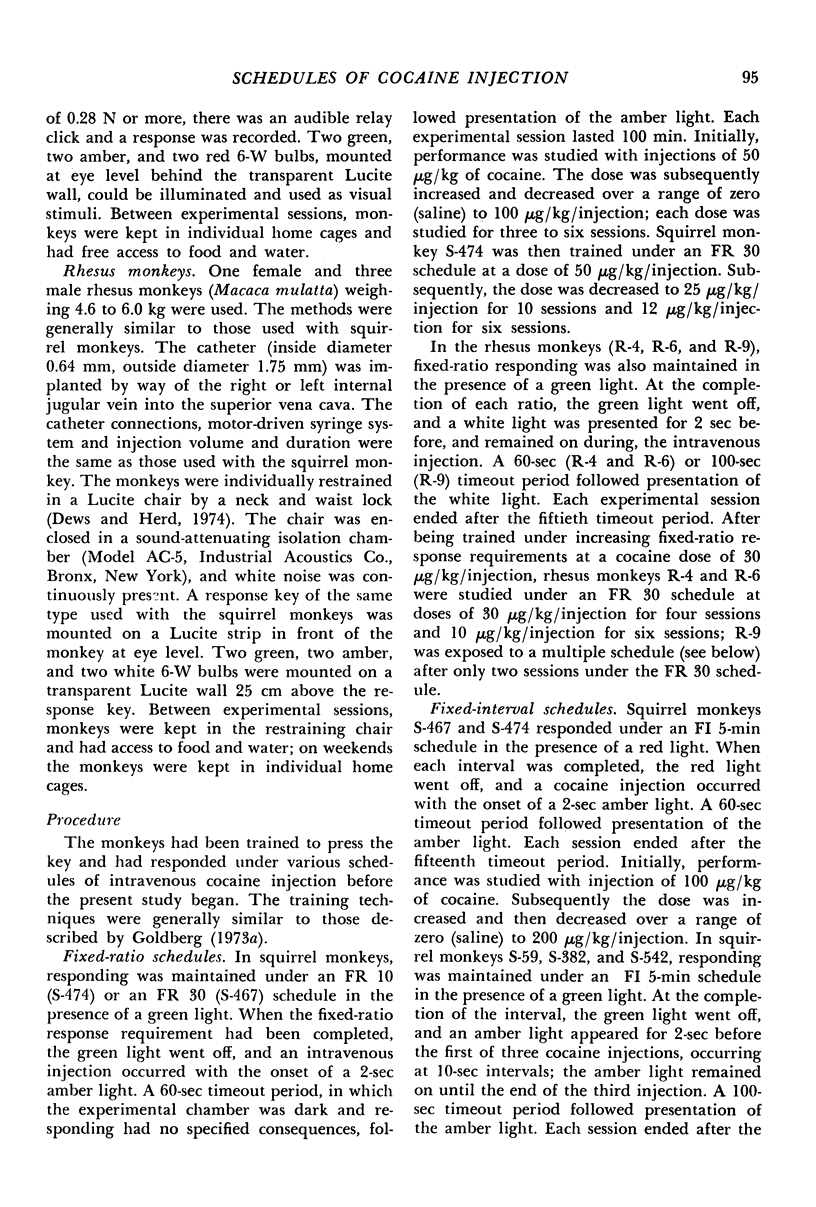
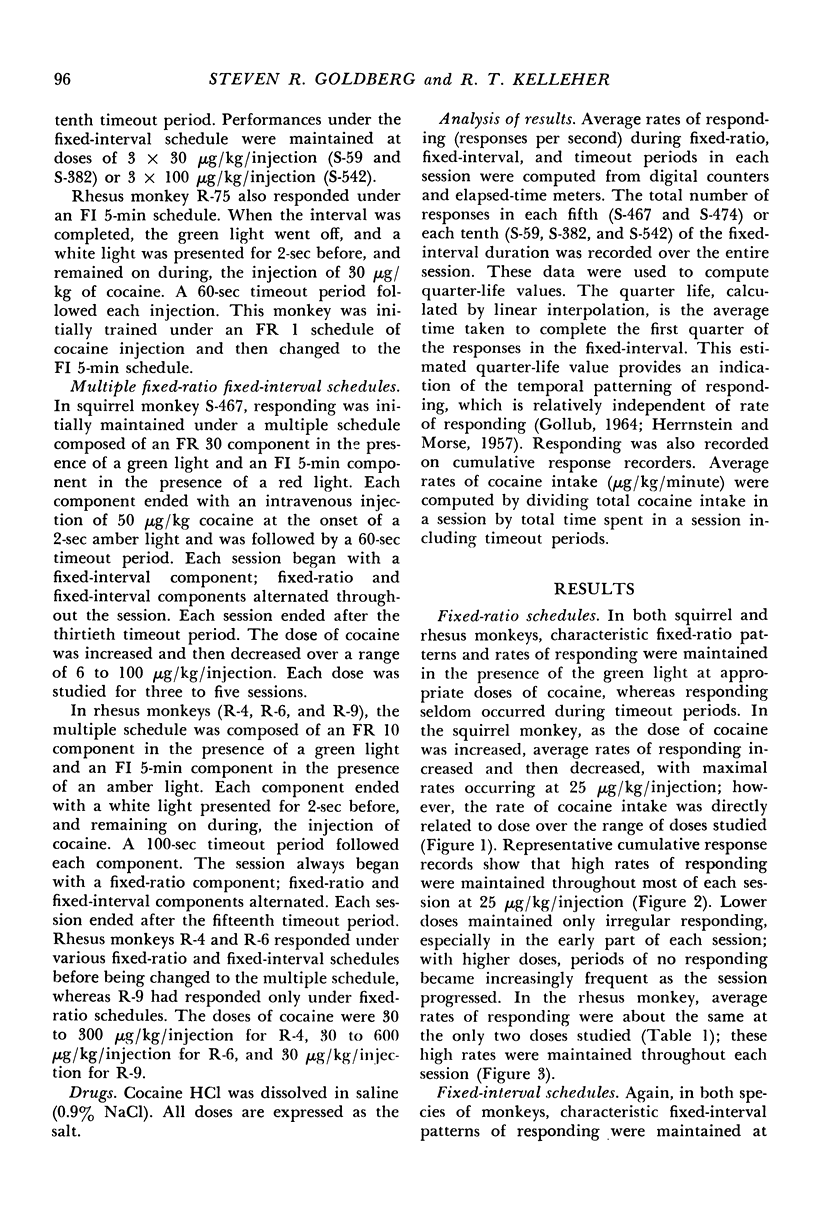
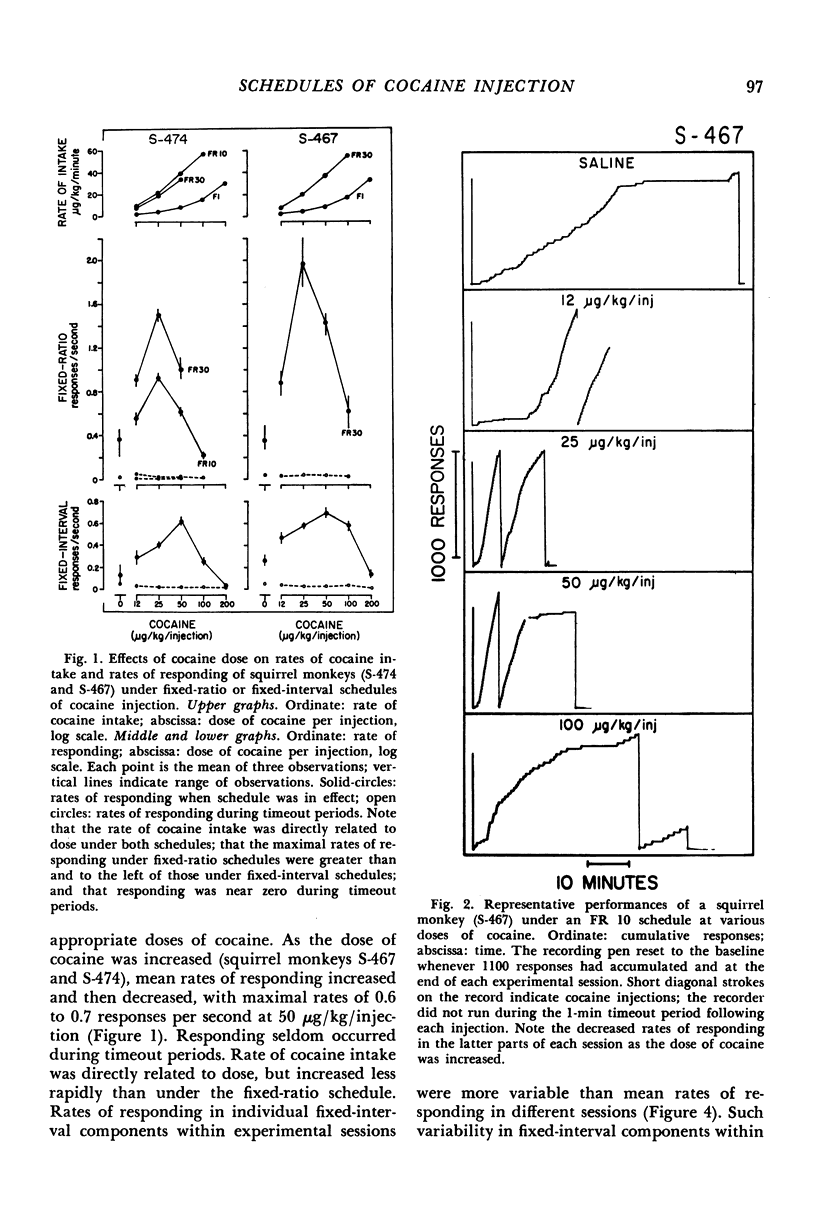


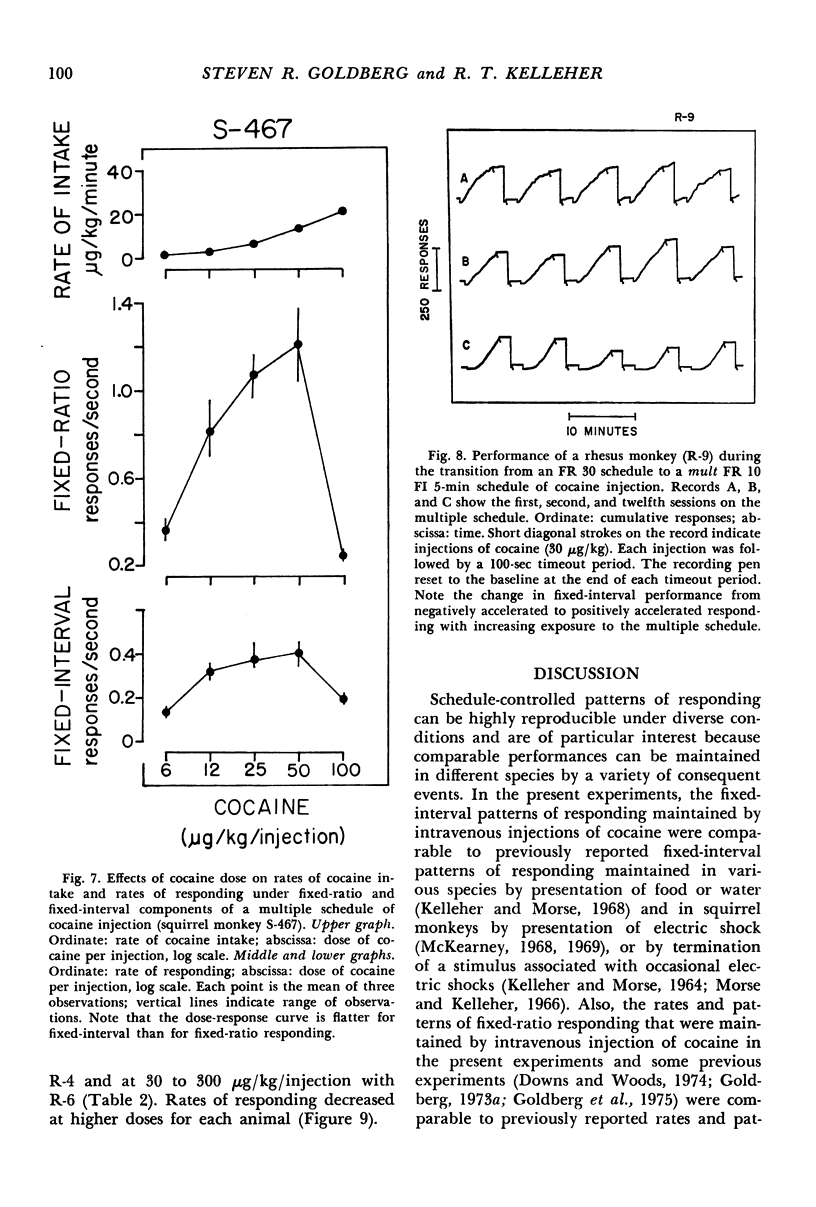

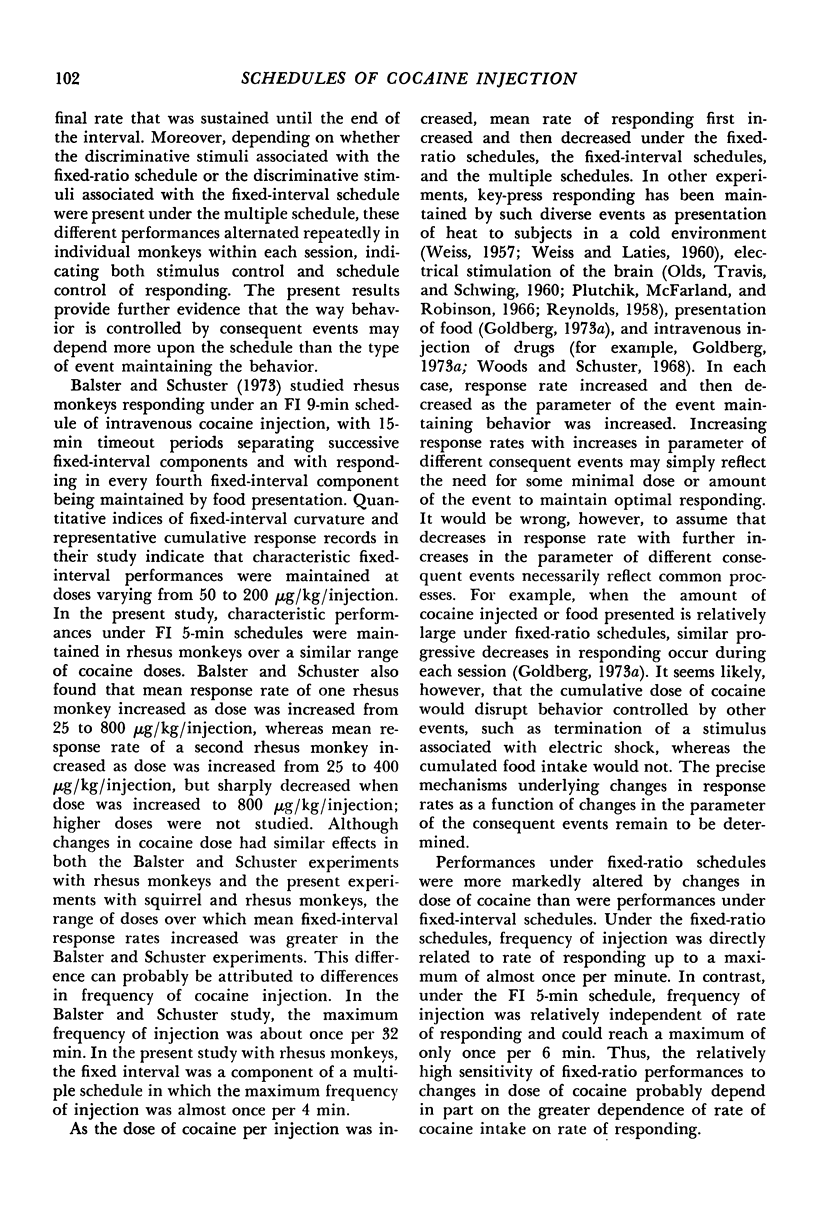


Selected References
These references are in PubMed. This may not be the complete list of references from this article.
- Balster R. L., Schuster C. R. Fixed-interval schedule of cocaine reinforcement: effect of dose and infusion duration. J Exp Anal Behav. 1973 Jul;20(1):119–129. doi: 10.1901/jeab.1973.20-119. [DOI] [PMC free article] [PubMed] [Google Scholar]
- DEWS P. B. The measurement of the influence of drugs on voluntary activity in mice. Br J Pharmacol Chemother. 1953 Mar;8(1):46–48. doi: 10.1111/j.1476-5381.1953.tb00749.x. [DOI] [PMC free article] [PubMed] [Google Scholar]
- Deneau G., Yanagita T., Seevers M. H. Self-administration of psychoactive substances by the monkey. Psychopharmacologia. 1969;16(1):30–48. doi: 10.1007/BF00405254. [DOI] [PubMed] [Google Scholar]
- Dews P. B., Herd J. A. Behavioral activities and cardiovascular functions: effects of hexamethonium on cardiovascular changes during strong sustained static work in rhesus monkeys. J Pharmacol Exp Ther. 1974 Apr;189(1):12–23. [PubMed] [Google Scholar]
- Dougherty J., Pickens R. Fixed-interval schedules of intravenous cocaine presentation in rats. J Exp Anal Behav. 1973 Jul;20(1):111–118. doi: 10.1901/jeab.1973.20-111. [DOI] [PMC free article] [PubMed] [Google Scholar]
- Downs D. A., Woods J. H. Codeine- and cocaine-reinforced responding in rhesus monkeys: effects of dose on response rates under a fixed-ratio schedule. J Pharmacol Exp Ther. 1974 Oct;191(1):179–188. [PubMed] [Google Scholar]
- Fog R. Stereotyped and non-stereotyped behaviour in rats induced by various stimulant drugs. Psychopharmacologia. 1969;14(4):299–304. doi: 10.1007/BF02190114. [DOI] [PubMed] [Google Scholar]
- GOLLUB L. R. THE RELATIONS AMONG MEASURES OF PERFORMANCE ON FIXED-INTERVAL SCHEDULES. J Exp Anal Behav. 1964 Sep;7:337–343. doi: 10.1901/jeab.1964.7-337. [DOI] [PMC free article] [PubMed] [Google Scholar]
- Goldberg S. R. Comparable behavior maintained under fixed-ratio and second-order schedules of food presentation, cocaine injection or d-amphetamine injection in the squirrel monkey. J Pharmacol Exp Ther. 1973 Jul;186(1):18–30. [PubMed] [Google Scholar]
- Goldberg S. R., Hoffmeister F., Schlichting U. U., Wuttke W. A comparison of pentobarbital and cocaine self-administration in rhesus monkeys: effects of dose and fixed-ratio parameter. J Pharmacol Exp Ther. 1971 Nov;179(2):277–283. [PubMed] [Google Scholar]
- Goldberg S. R., Kelleher R. T., Morse W. H. Second-order schedules of drug injection. Fed Proc. 1975 Aug;34(9):1771–1776. [PubMed] [Google Scholar]
- HERRNSTEIN R. J., MORSE W. H. Effects of pentobarbital on intermittently reinforced behavior. Science. 1957 May 10;125(3254):929–931. doi: 10.1126/science.125.3254.929-a. [DOI] [PubMed] [Google Scholar]
- Herd J. A., Morse W. H., Kelleher R. T., Jones L. G. Arterial hypertension in the squirrel monkey during behavioral experiments. Am J Physiol. 1969 Jul;217(1):24–29. doi: 10.1152/ajplegacy.1969.217.1.24. [DOI] [PubMed] [Google Scholar]
- KELLEHER R. T., GILL C. A., RIDDLE W. C., COOK L. On the use of the squirrel monkey in behavioral and pharmacological experiments. J Exp Anal Behav. 1963 Apr;6:249–252. doi: 10.1901/jeab.1963.6-249. [DOI] [PMC free article] [PubMed] [Google Scholar]
- KELLEHER R. T., MORSE W. H. ESCAPE BEHAVIOR AND PUNISHED BEHAVIOR. Fed Proc. 1964 Jul-Aug;23:808–817. [PubMed] [Google Scholar]
- Kelleher R. T., Morse W. H. Determinants of the specificity of behavioral effects of drugs. Ergeb Physiol. 1968;60:1–56. doi: 10.1007/BFb0107250. [DOI] [PubMed] [Google Scholar]
- McKearney J. W. Fixed-interval schedules of electric shock presentation: extinction and recovery of performance under different shock intensities and fixed-interval durations. J Exp Anal Behav. 1969 Mar;12(2):301–313. doi: 10.1901/jeab.1969.12-301. [DOI] [PMC free article] [PubMed] [Google Scholar]
- McKearney J. W. Maintenance of responding under a fixed-interval schedule of electric shock-presentation. Science. 1968 Jun 14;160(3833):1249–1251. doi: 10.1126/science.160.3833.1249. [DOI] [PubMed] [Google Scholar]
- Morse W. H., Kelleher R. T. Schedules using noxious stimuli. I. Multiple fixed-ratio and fixed-interval termination of schedule complexes. J Exp Anal Behav. 1966 May;9(3):267–290. doi: 10.1901/jeab.1966.9-267. [DOI] [PMC free article] [PubMed] [Google Scholar]
- OLDS J., TRAVIS R. P., SCHWING R. C. Topographic organization of hypothalamic self-stimulation functions. J Comp Physiol Psychol. 1960 Feb;53:23–32. doi: 10.1037/h0039776. [DOI] [PubMed] [Google Scholar]
- Pickens R., Thompson T. Cocaine-reinforced behavior in rats: effects of reinforcement magnitude and fixed-ratio size. J Pharmacol Exp Ther. 1968 May;161(1):122–129. [PubMed] [Google Scholar]
- Plutchik R., McFarland W. L., Robinson B. W. Relationships between current intensity, self-stimulation rates, escape latencies, and evoked behavior in rhesus monkeys. J Comp Physiol Psychol. 1966 Apr;61(2):181–188. doi: 10.1037/h0023128. [DOI] [PubMed] [Google Scholar]
- Scheel-Krüger J. Behavioural and biochemical comparison of amphetamine derivatives, cocaine, benztropine and tricyclic anti-depressant drugs. Eur J Pharmacol. 1972 Apr;18(1):63–73. doi: 10.1016/0014-2999(72)90132-x. [DOI] [PubMed] [Google Scholar]
- WEISS B., LATIES V. G. Magnitude of reinforcement as a variable in thermoregulatory behavior. J Comp Physiol Psychol. 1960 Dec;53:603–608. doi: 10.1037/h0047935. [DOI] [PubMed] [Google Scholar]
- WEISS B. Thermal behavior of the sub-nourished and pantothenic-acid-deprived rat. J Comp Physiol Psychol. 1957 Oct;50(5):481–485. doi: 10.1037/h0042270. [DOI] [PubMed] [Google Scholar]


